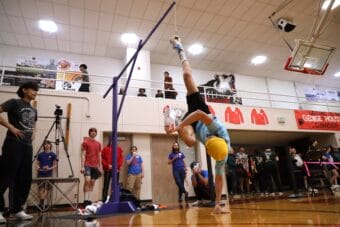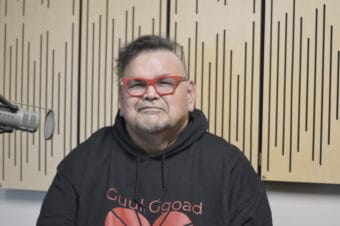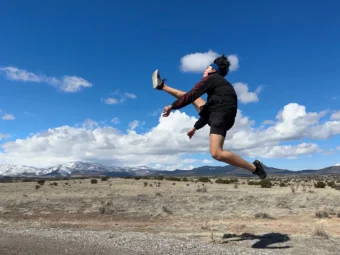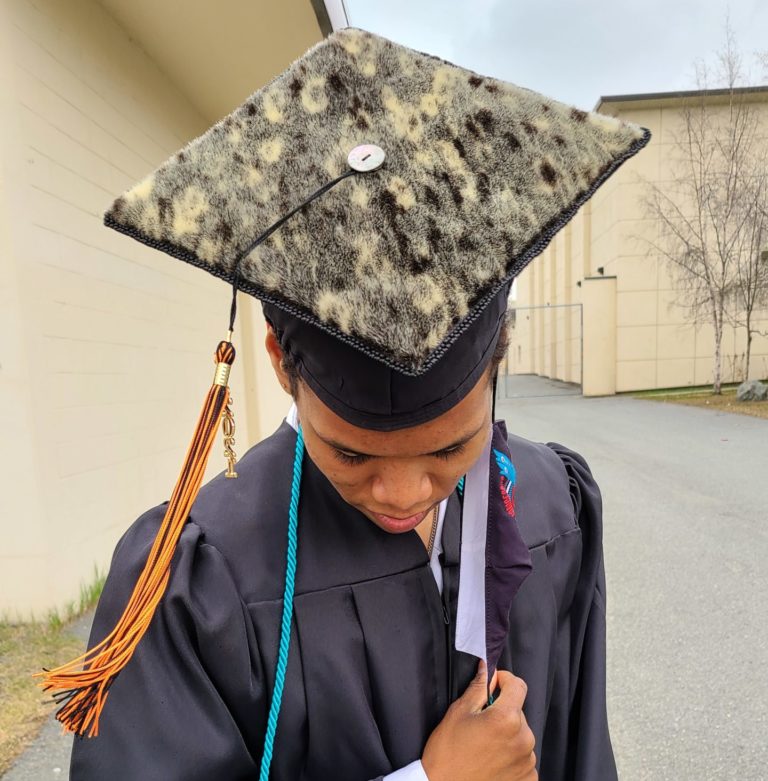
Ayyu Qassataq thought it’d be easy to spot her son at his West Anchorage High School graduation on Monday.
When David Paoli left his family to join his peers on the way to the outdoor ceremony, he was wearing a graduation cap decorated in sealskin — a way to honor his Iñupiaq culture during a major milestone.
But as Qassataq and her family looked out at the sea of graduates gathered at the football stadium, they couldn’t pick him out.
A school employee had taken his sealskin cap away. They told Paoli it violated the rules and gave him a plain cap to wear instead.
Qassataq was outraged.
“What should have been a celebration of joy and honor for my family was taken away in a terrible way,” she said. “Knowing that historically Alaska’s education system was formed specifically to remove Alaska Native children from our cultures, I was so angry and sad at how incredibly unjust this continuation of that practice was.”
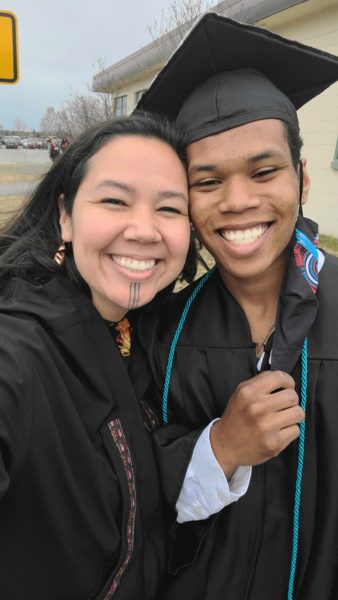
Immediately after the ceremony, Qassataq told West High’s principal and the Anchorage School District superintendent about what happened. West Principal Sven Gustafson apologized, saying Paoli should have been allowed to walk across the stage wearing his sealskin cap.
“These types of things are definitely allowed and we messed up,” Gustafson said. “We should have made sure we had everybody in the loop about what can be worn. I just feel terrible about it. All I can do is apologize.”
The mistake has prompted vows from district officials to review rules on what students can wear at graduation so that what happened to Paoli won’t happen again, they say. Some parents argue that a cornerstone of the district’s policy is flawed: Students should not need permission to wear cultural regalia at their graduations.
The policy that allows students to wear cultural regalia to graduation stems from a 2019 effort led by Alaska Native and Indigenous youth in the district to get it approved.
“There was a lot of passion,” said Doreen Brown, senior director for Title VI Indian Education and Migrant Education at the district. “They had a letter, and sent it to every tribe, tribal organization, Native corporation, and a lot of other Native organizations or businesses, and asked for their support as well. So there were letters that were sent in from across the state.”
Because of the pandemic, 2020 graduations were virtual or modified.
But for this year’s graduation season, many families and educators were excited to return to a more traditional ceremony. It marked the second time students could wear cultural regalia for graduation.
Qassataq’s son had encouraged her to create the sealskin cap specifically to celebrate graduations in their family.
The cap has sealskin on the mortar board, an abalone button and black beadwork edging. Qassataq said she designed it so it wouldn’t be disruptive or clash with any school colors, particularly West’s orange and black colors.
She was the first in her family to wear the cap, when she earned her master’s degree from the University of Alaska Fairbanks last year. She said she wanted to “Indigenize” her graduation attire. Ironically, she said, her master’s thesis was centered on the missionization of Alaska Native people and the formation Alaska’s education system and its ongoing impact to Native people and communities.
Her children all looked forward to wearing the cap to their own graduations, Qassataq said, starting with Paoli this year.
The process for him to wear the cap at West High’s graduation started with a formal notification to the district.
Currently, Anchorage families must notify the school district and principal about what their children would like to wear for graduation — and get approval.
District Superintendent Deena Bishop said the process is in place so students do not display symbols that may be offensive, such as a Confederate flag.
“To ensure that the students and the families that are at graduations don’t feel as though they are being harmed by the types of things shown and displayed. It’s just kind of a check to be sure that there isn’t really any funny business going on,” she said.
The district received 96 notifications from families planning to wear regalia to graduation this year — up from 70 two years ago, said Brown. Notifications came from students from a variety of backgrounds she said, including Hmong and Pacific Islander students as well as Alaska Native and American Indian students.
“It represents diversity within our district,” Brown said. “And I think that’s a great thing.”
But Qassataq said she was disturbed by the requirement.
“It is unjust that Native students and families have to seek approval or permission from the district to honor our own cultures on this important day,” Qassataq said.
Families have been pushing back on the notification requirement since the policy was approved, calling it “demeaning.”
Qassataq said she “did what was necessary” and sent in the notification form for her son to wear the cap.
ASD Secondary Director Kersten Johnson-Struempler said families that submit notifications, which can include images of the regalia or descriptions, are not rejected if their request raises questions.
“Our process isn’t to say no. Our process is to give that to the school principal, and they have a conversation with the student and the family,” Johnson-Struempler said. “In almost all cases, we’re able to come to an agreement of what’s coming to graduation and it still represents the student well as they cross the stage.”
Qassataq said she did not hear back from any district administrators regarding the notification and assumed the cap was OK.
To still have the cap removed, Qassataq said, reflected a deeper institutional problem with the way Alaska’s educational system treats Native students.
“If every single ASD educator was trained and educated about the history of Alaska Native cultures, and the history of the education system, this incident never would have happened,” she said. “They would have been able to identify that this is an item of cultural significance. They would have been centered in how important it is to uplift and celebrate Alaska Native culture and pride. And they would have been protective of that.”
“This exemplifies the ways that the education system has been weaponized against Alaska Native children from its very formation, and that the way the education system was set up was explicitly to remove Alaska Native children from our culture. And this is a painful reminder, not only of that legacy, but also of how much there is to do in order to overcome and move beyond it.”
Ivalu Blanchett also graduated from West High this week, but she wasn’t able to come to an agreement with the school.
Blanchett wanted to wear a beaded Greenlandic shawl her mother made for her. She sent in her notification.
“I thought that this is the perfect opportunity to express myself in that way,” Blanchett said.
But then, she said, a school administrator told her family the shawl was too big.

“They said I could wear it under my cap and gown. And then after I walked across the stage, after all of that was over with I could put it over my gown,” Blanchett said. “Which is really saying that I’m not allowed to wear it at all for the actual ceremony.”
Blanchett decided not to attend the graduation ceremony at all. Her family held a private celebration instead.
“I felt like if I participated, it would only be for superficial reasons, because I wouldn’t be able to celebrate this accomplishment, authentically, connect with my culture and make my mom proud,” she said. “I’m wearing something that she worked so hard to make for me, for this type of situation. And so I just thought to be more true to my values and my identity and culture that I would much rather just have a private ceremony with my loved ones.”
Gustafson, the principal, said a staff member misinterpreted the district’s policy and he apologized to the Blanchett’s for the miscommunication.
Blanchett described that as the first step.
“Apologizing is not all you can do,” she said. “I think there definitely needs to be more learning about different institutions outside of this very one-sided institution they have in place today.”
Brown said work on the policy continues.
The NAACP and the Alaska Coalition of BIPOC Educators have asked the district to remove the notification requirement, saying it’s a continuation of the painful history of colonization through the education system in Alaska against Native students.
Meanwhile, Brown said the district’s Native advisory committee drafted a resolution in April to expand what students can wear as part of their cultural regalia. But it won’t impact this year’s graduates.
After Paoli’s sealskin cap was wrongly taken away, Qassataq asked the district to ensure it would never happen again to another Native student or family by changing the policy and instituting mandatory training for all school district staff about Alaska Native peoples, cultures and history. Bishop committed to ensuring that both will happen, Qassataq said.
Bishop said the district is also taking more immediate actions.
The district is “overly communicating” with district principals to ensure other students attending the rest of the district’s scheduled graduation ceremonies are encouraged to wear their regalia, even if they missed the notification deadline, Bishop said. The district will officially review the policy as soon as this year’s graduation ceremonies are done, she said.
“As superintendent of the school district, I need to tell you that I do take responsibility that something such as this did happen under my watch,” she said. “It was very hurtful to the family, to the child, and that was never my intention for this regulation.”
While Qassataq will never get her oldest son’s graduation day back, she said, at the very least she hopes “this terrible experience can serve as a catalyst for the policy changes and training that is both overdue and desperately needed.”
“All Alaskans live on Native land and should know about and value our cultural knowledge and practices so incidents like these never harm another Native family,” she said. “Our city and state are stronger when our Indigenous peoples thrive.”

